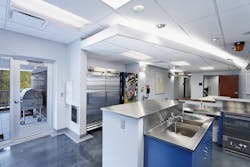Recipe for Success: Five Ingredients for Your Ideal Fire Station Kitchen
First we must ask, what is your ideal kitchen?
Let the answers begin pouring in: plenty of prep space, mobility, easy to clean and manage, lots of storage, shining surfaces, a place to hang out, secure refrigerators, etc. This list could fill the entire article, which is what makes kitchen design exciting, but also difficult. How can you capture your most important and desired elements of a kitchen without blowing the budget or affecting the schedule? Furthermore, how can an entire department come to an agreement on what should be included?
These are the questions that fire departments face with every opportunity to design a new facility or renovate an existing one.
When designing your fire station’s kitchen, a number of things must be considered long before the final decision is made to include an additional refrigerator. Understanding how the station functions, the relationships between company members, and their ideal space for efficiency and traffic flow are just a few considerations. It is imperative that those interacting most with the space possess a high degree of comfort with the functionality of the kitchen. With these factors in mind, historical lessons and design experience have shown the following five baseline considerations help guide your kitchen’s recipe for success: durability, clean-ability, flexibility, comfort, and storage.
Durability
Whether for a large department in a big city, staffed 24/7, or a small volunteer department, the kitchen and day room are the two most-utilized spaces within a fire station. For this reason, very close attention must be paid to the durability of materials to ensure that the station will look and feel good for years to come without requiring constant, and costly, repair. With all of the pieces and parts that come together in creating a durable kitchen, countertops, cabinets, appliances, and flooring tend to be the items receiving the most abuse.
The important questions when it comes to countertops are similar to those for your home: How will it look? Can it withstand a hot pot or pan? How easy is it to clean? How much will it cost?
Let’s break this down. One common route is plastic laminate. While this is a value-driven option and important to add a little wiggle room to the budget for other items, its limited lifespan was not designed to withstand the abuse of a fire station kitchen environment. On the opposite end of the spectrum, natural stone countertops, such as granite or marble, come in at a much higher price, but provide a high level of strength in the material. Even with the durability of stone, using the wrong cleaning solution can easily stain the surfaces, which are difficult and expensive to repair. With a large number of individuals using and cleaning the kitchen, this often proves difficult to prevent.
Solid surface is a good choice for countertops as it has a good balance of cost and durability. These countertops are easily cleaned and can be sanded and repaired in the off chance that they are damaged. Stainless steel countertops are another excellent choice and come at a similar price point to natural stone. Stainless is easily cleaned, extremely durable, can withstand the hot pan, and the marine edge keep liquids from rolling down the face of the cabinets. These can also be made with integral drain boards and sinks to create more sanitary conditions.
Once a countertop selection is made, it’s time to consider cabinetry. The Architectural Woodworking Institute (AWI) has three grades for cabinets: economy, custom, and premium. While economy grade can carry the load for residential applications, taking the inexpensive route on fire station kitchen cabinetry could end up costing more over time.
For durability, fire stations start in the premium category and many times are forced out of wood all together. In smaller fire stations, cabinets constructed of full plywood, with dovetail and dado joints, and PVC edge banding should hold up well in day-to-day use. In larger stations, staffed 24/7, these fairly sturdy cabinets may not suffice. When longevity is most important and budget allows, steel or solid surface cabinets similar to those you might find in a laboratory environment provide the durability and resistance to corrosion imperative in a heavily utilized kitchen space.
Clean-Ability
The cleaning regimen defines fire station culture. Anything that can be leveraged to make quick work of day-to-day cleaning is an important consideration when designing a new fire facility. As such, the kitchen is a space that requires careful attention to cleanliness to avoid potentially debilitating food-borne illness. This goes beyond countertops and includes flooring, seating, ceilings and wall finishes.
While it’s easy to focus on countertops as a first line of defense, floors are often the culprit that most often transport food around the kitchen. The gold standard for fire station kitchen floors is the epoxy resin floor. This material offers a homogenous surface with superior water-, stain- and slip-resistance. It can be installed with edges turned up at the walls to create a durable wall base that makes it easy to mop, clean or hose down. However, if the look and feel of a poured floor doesn’t appeal to the department, porcelain tile can be a solid alternative. With tile applications in the kitchen, special attention must be paid to minimize and seal the grout joints to prevent a difficult to clean dirt and grime trap.
On kitchen walls, selecting the paint grade and correct level of sheen is important to offer a surface that can withstand constant scrubbing without degradation. Selecting an appropriate base can improve the ability to clean the floors, while protecting the walls from constant scuffs and scrapes where bacteria can fester and grow. Additionally, there are a number of areas on both the walls and ceilings in which special treatments are required to meet codes and improve kitchen cleanliness. One such method suggests applying stainless steel to the wall behind the commercial range, achieving the separation of combustible materials from the range and an easily cleaned surface.
Flexibility
Mirroring residential trends, the need for the fire station kitchen to be a flexible environment with an open floor plan is rapidly growing. Kitchens can be designed to incorporate multiple layers of seating to allow for large, company-wide sit-down meals, smaller groups occupying bar-top space, and enough space for others to stand and move around. Having a door directly to an exterior patio with a grill provides flexible cooking options. Many departments are also beginning to incorporate rolling stainless steel prep tables into the design of their kitchens. This offers the ability to reconfigure the room to the number of people helping in the preparation and can be relocated to ease the process of cleaning the floors. Flexible spaces can go a long way in creating a comfortable kitchen for teams to live and work in.
Comfort
Providing a connection to exterior and adjacent spaces keeps spaces breathable and open. Numerous studies have demonstrated the positive effects of natural light and views of the outdoors; these relationships are key when determining the kitchen location and layout. To supplement a space’s natural lighting, easily controlled task lighting can help reduce eye-strain and create energy savings by placing the light exactly where it is needed.
Managing your workflow triangle is imperative to limit frustration. This refers to laying out a kitchen in a manner that creates a triangle between the refrigerator, kitchen sink and range. The idea is that you can create efficiency in travel between these areas while preparing a meal. In the design of a fire station kitchen, it’s best to consider expanding the triangle to ensure multiple people can work together when preparing a meal. For example, providing a three-bowl sink with wide and deep compartments and two high-clearance faucets with spray options can make it easy for people to work together to wash, rinse, dry and put dishes away.
Storage
Making certain that every pot, pan and wooden spoon has a clear place in the kitchen can help work flow in a kitchen and the culture of the department as a whole. This extends to one of the most important considerations in the design of a fire station kitchen: food storage. Being certain that the strategy for storage of food is clearly defined and supported by the layout will help to promote positive relationships within the station. Separate pantries and refrigerators are often provided for each shift to avoid confusion about whose food is whose. There should be a very clear place for shared items, such as condiments and spices to avoid any unintended consequences.
Bringing It All Together
Every fire department has its own culture and ideal kitchen. When designing a fire station kitchen, it is extremely important to first understand the culture and taboos that exist well before putting pen to paper. With due diligence and department buy-in, moving forward with the recipe of durability, clean-ability, flexibility, comfort and storage for your space will ensure an ideal kitchen environment that lasts.
TIM WILEY, AIA, LEED AP BD+C and CHRIS GRAHAM, AIA, LEED AP are the client leader and lead architect for Public Safety Design at CR architecture + design. With more than 200 government projects, 40-plus design awards, and more than $50 million in client savings from design expertise, CR architecture + design is a national leader and knowledge authority in public safety design. As the pioneer of the Training by Design program, CR has partnered with departments across the U.S. to increase training effectiveness and efficiency.






